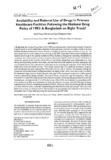| dc.contributor.author | Ahmed, Syed Masud | |
| dc.contributor.author | Islam, Qazi Shafayetul | |
| dc.date.accessioned | 2019-12-01T05:54:16Z | |
| dc.date.available | 2019-12-01T05:54:16Z | |
| dc.date.issued | 2010 | |
| dc.identifier.citation | Ahmed, S. M., & Islam, Q. S. (2010). Availability and rational use of drugs in primary healthcare facilities following the National Drug Policy of 1982: is Bangladesh on right track? Research Reports (2010): Health Studies, Vol - XLII, 1–10. | en_US |
| dc.identifier.uri | http://hdl.handle.net/10361/13155 | |
| dc.description.abstract | In Bangladesh, the National Drug Policy (NDP) 1982 was instrumental in improving the supply of essential drugs of quality at an affordable price, especially in the early years. However, over time, evidence showed that the situation deteriorated in terms of both availability of essential drugs and their rational use. The study examined the current status of the outcome of the NDP objectives in terms of the availability and rational use of drugs in the primary healthcare (PHC) facilities in Bangladesh, including affordability by consumers. The study covered a random sample (n=30) of rural Upazila Health Complexes (UHCs) and a convenient sample (n=20) of urban clinics (UCs) in the Dhaka metropolitan area. Observations on prescribing and dispensing practices were made, and exit-interviews with patients and their attendants, and a mini-market survey were conducted to collect data on the core drug-use indicators of the World Health Organization from the health facilities. The findings revealed that the availability of essential drugs for common illnesses was poor, varying from 6% in the UHCs to 15% in the UCs. The number of drugs dispensed out of the total number of drugs prescribed was higher in the UHCs (76%) than in the UCs (44%). The dispensed drugs were not labelled properly, although >70% of patients/care-givers (n=1,496) reported to have understood the dosage schedule. The copy of the list of essential drugs was available in 55% and 47% of the UCs and UHCs respectively, with around two-thirds of the drugs being prescribed from the list. Polypharmacy was higher in the UCs (46%) than in the UHCs (33%). An antibiotic was prescribed in 44% of encounters (n=1,496), more frequently for fever (36-40%) and common cold (26-34%) than for lower respiratory tract infection, including pneumonia (10-20%). The prices of key essential drugs differed widely by brands (500% or more), seriously compromising the affordability of the poor people. | en_US |
| dc.language.iso | en | en_US |
| dc.publisher | BRAC Research and Evaluation Division (RED) | en_US |
| dc.subject | Costs and cost analysis | en_US |
| dc.subject | Drug-use | en_US |
| dc.subject | Drugs | en_US |
| dc.subject | Health expenditure | en_US |
| dc.subject | National Drug Policy 1982 | en_US |
| dc.subject | Bangladesh | en_US |
| dc.subject.lcsh | Drug control--International cooperation | |
| dc.subject.lcsh | Drug abuse--Government policy | |
| dc.subject.lcsh | Drug abuse surveys | |
| dc.subject.lcsh | Pharmaceutical policy | |
| dc.title | Availability and rational use of drugs in primary healthcare facilities following the National Drug Policy of 1982: is Bangladesh on right track? | en_US |
| dc.type | Research paper | en_US |

